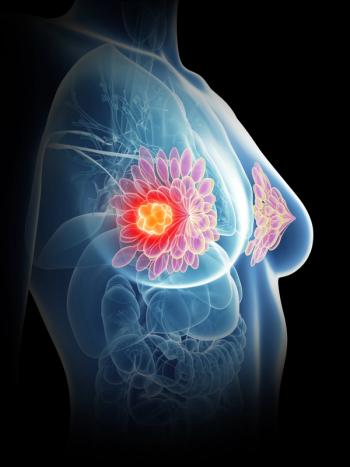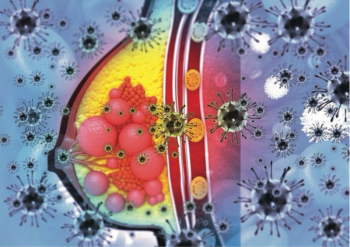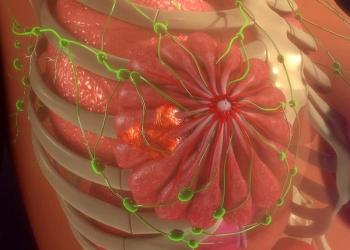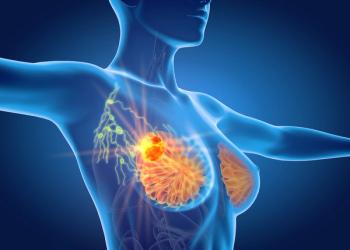
- ONCOLOGY Vol 12 No 3
- Volume 12
- Issue 3
Preclinical Studies Using the Intratumoral Aromatase Model for Postmenopausal Breast Cancer
To determine the most effective strategies for the treatment of postmenopausal hormone dependent breast cancer, we recently developed a model system in nude mice. In this model, estrogen receptor-positive human breast cancer cells (MCF-7) stably transfected with the aromatase gene are inoculated into ovariectomized, immunosuppressed (nude) mice.
ABSTRACT: To determine the most effective strategies for the treatment of postmenopausal hormone dependent breast cancer, we recently developed a model system in nude mice. In this model, estrogen receptor-positive human breast cancer cells (MCF-7) stably transfected with the aromatase gene are inoculated into ovariectomized, immunosuppressed (nude) mice. These cells synthesize sufficient estrogen from androgen substrate to stimulate their proliferation and the development of tumors. Moreover, estrogen secreted by the tumor cells maintains uterine weight comparable to that of the intact mouse. In the present study, we employed this model to investigate the effects of the aromatase inhibitor, letrozole (CGS 20267 [Femara]) on mammary tumor growth and on the uterus. We also used this model to predict the effects of combining two aromatase inhibitors, letrozole and anastrozole (Arimidex), with the antiestrogen tamoxifen (Nolvadex). Letrozole was found to be a highly potent inhibitor of tumor proliferation and more effective than tamoxifen. No stimulation of uterine growth was observed with the aromatase inhibitors. However, the combination of letrozole or anastrozole and tamoxifen was no more effective than either aromatase inhibitor alone. The agonistic effect of tamoxifen on the uterus was observed when it was given alone and when combined with the aromatase inhibitors. Furthermore, letrozole had the most potent antitumor activity when compared to other aromatase inhibitors and antiestrogens. No additional benefit was observed by combining these agents with tamoxifen over treatment with aromatase inhibitors alone.[ONCOLOGY(Suppl 5):36-40, 1998]
When we began the development of aromatase inhibitors for breast cancer treatment a number of years ago, our objective was to block effectively the synthesis of estrogen in all tissues with compounds that had no estrogenic or agonistic effects, in contrast to the antiestrogens used at that time. Although substantial beneficial effects of tamoxifen (Nolvadex) are now apparent,[1,2] this antiestrogen has the disadvantage of acting as a weak agonist on the endometrium. This has led to endometrial hyperplasia and cancer in some breast cancer patients.[3,4] It also seemed possible that tamoxifen may not optimally suppress the effects of estrogen on tumor proliferation. Thus, complete blockade of estrogen synthesis may be more effective.[5]
We first reported on estrogen synthetase (aromatase) inhibitors in 1973,[6] and subsequently 4-hydroxyandrostenedione was developed as the first selective aromatase inhibitor for breast cancer treatment.[7] In the interim, aminoglutethimide (Cytadren), first used as an anticonvulsant but later found to inhibit steroidal hydroxylations by adrenal P450 enzymes, was employed to reduce estrogen production in breast cancer patients.[8] Numerous steroidal and nonsteroidal compounds have now been reported to inhibit aromatase.[5] The steroidal inhibitors are substrate analogs, whereas the nonsteroidal compounds tend to be less specific for aromatase.
Recently, two triazole compounds with good specificity for aromatase have been approved for the treatment of breast cancer in the United States.[9] Letrozole (CGS 20267 [Femara]), 4-[1-(cyanophenyl)-1-(1,2,4-triazolyl) methyl] benzonitril, is a highly potent inhibitor of aromatase that reduces plasma estrogen levels to the limit of detection in postmenopausal patients.[10] Similar effects are observed with anastrozole (ZD1033 [Arimidex]), 2,2¢[5-(1H-1,2,4-triazol-1-yl methyl)-1,3 phenylene]bis(2-methylpropiononitrile).
Clinical trials of these new agents have been carried out in patients with advanced breast cancer who had relapsed after treatment with other agents.[11] Results from these trials have provided the important observation that aromatase inhibitors are effective in some patients who have relapsed and become resistant to tamoxifen and other treatments. However, evaluating the inhibitors as first-line agents has been difficult since almost all patients receive tamoxifen initially. We have, therefore, developed a model that is relevant to postmenopausal patients with hormone-dependent disease in order to study the effects of aromatase inhibitors and antiestrogens.[12]
After menopause, when the ovary ceases production of estrogen, synthesis in nongonadal tissues increases. The main sources of circulating estrogens in postmenopausal women are adipose and muscle tissues, which make up the largest proportion of body mass. The breast also synthesizes estrogens. The concentrations of estrogen in the breast tissue of postmenopausal patients have been found to be higher than levels in plasma and similar to levels in the breast tissue of premenopausal women.
Aromatase activity has been detected in approximately 60% of tumors in breast cancer patients. Aromatase is expressed in epithelial and stromal cells of the normal breast and breast tumors.[13] Intratumoral estrogen synthesis can result in high local concentrations of estrogen. We recently demonstrated that this has functional significance and results in enhanced tumor proliferation.[13]
In our model, we use ovariectomized nude mice to simulate the postmenopausal situation.[12,14,15] Since the rodent has no significant production of estrogen from nonovarian tissue, we inoculate the mice with human breast cancer cells (MCF-7) transfected with the aromatase gene to provide the intratumoral source of estrogen. The tumors produced from the MCF-7 cells transfected with the aromatase gene proliferate faster than those in the same animal without aromatase, which depends on circulating estrogen from adjacent tumors.[16]
In the present study aimed at optimizing treatment strategies, we used this model to investigate the effects of letrozole and anastrozole on tumor growth, as well as on the uterus. We compared these effects with those of tamoxifen alone or in combination with the aromatase inhibitors.[17]
Athymic Mice
Female BALB/c athymic mice 4 to 6 weeks of age (obtained from the National Cancer Institute [NCI], Frederick, Maryland) were housed in a pathogen-free environment under controlled conditions of light and humidity and received food and water ad libitum. Ovariectomy was carried out under halothane (Fluothane) anesthesia 1 to 3 days before inoculation of breast cancer cells.
Cell Culture and Inoculation
Human estrogen-dependent, breast carcinoma MCF-7 cells, stably transfected with the human placental aromatase gene, were used for tumor inoculation, as reported previously.[12] The cells were cultured in Eagles minimum essential medium containing 5% fetal bovine serum and neomycin (600 mg/mL; GIBCO, Bethesda, Maryland), with medium changes twice weekly.
When the cells reached subconfluence, they were scraped into Hanks solution and centrifuged at 1,000 rpm for 2 minutes at 4 °C. The cells were then mixed with Matrigel (10 mg/mL, supplied by Dr. Hynda Kleinman, NCI) to yield a suspension of 2 to 5 ´ 107 cells/mL. Each mouse was inoculated subcutaneously with 0.1 mL of the cell suspension at four sites. Injections of 0.1 mg/mouse/d of androstenedione were begun and continued for the course of the experiment.
Tumor growth rates were monitored weekly by measuring the tumors in two dimensions with calipers. As previously, tumor volumes were calculated using the formula 4/3 ´ p ´ r12 ´ r2(r1 < r2).[7]
Treatment
Treatment with the aromatase inhibitor letrozole and the antiestrogen tamoxifen began 21 to 35 days after inoculation of the cells, when the tumors had reached a measurable size. The mice were assigned to groups of four or five and received daily subcutaneous injections of 10 or 60 mg/mouse/d of letrozole (provided by Dr. A. Bhatnagar, Novartis Pharma, Basel, Switzerland) or 60 mg/mouse/day of tamoxifen (provided by Dr. A. Wakeling, Zeneca, Macclesfield, United Kingdom) in 0.3% hydroxypropyl cellulose (HPC), or vehicle (0.3% HPC, 0.1 mL/mouse/d) for 56 days. Tumors were measured weekly, and the percentage change in total tumor volume was calculated.
In experiments using combined treatment, groups of four mice received daily subcutaneous injections of 5 mg/mouse/d of letrozole, 5 mg/mouse/d of anastrozole (provided by Dr. D. Duke, Zeneca, Macclesfield, United Kingdom), 3 mg/mouse/d of tamoxifen, letrozole plus tamoxifen, anastrozole plus tamoxifen, or vehicle. After 4 to 5 weeks, the mice were autopsied 4 or 6 hours after the last injection. The uteri and multiple small tumors at each inoculation site were removed and weighed. Statistical differences in tumor weights were compared by analysis of variance.
Results and Discussion
In the control mice, all tumors continued to increase in volume throughout the course of the experiments. Treatment with both aromatase inhibitors, letrozole and anastrozole, as well as tamoxifen, markedly suppressed tumor growth.[17] Tamoxifen was clearly more effective at a dose of 60 mg/d (Figure 1) than at 3 mg/d (Figure 2). However, tamoxifen (60 mg/d) was not as effective as letrozole, which showed equivalent responses at 10 and 60 mg/d in the same experiment (Figure 1 and Table 1). In fact, in a further experiment, letrozole not only reduced tumor growth but also caused tumor regression. Thus, tumors of mice autopsied before starting treatments in this experiment were significantly larger than those removed from animals after treatment with letrozole (60 mg/mouse/d) (P < .05).[17]
Estrogen produced by the MCF-7 cells during aromatization of androstenedione is sufficient not only to stimulate tumor growth but also to maintain the uteri of these ovariectomized mice at a weight comparable to that of intact mice producing ovarian estrogen. By inhibiting intratumoral aromatase and reducing estrogen production, letrozole treatment significantly decreased mean uterine weight (P < .01), as compared to uterine weight of control mice. In contrast, the mean weight of uteri from the tamoxifen-treated animals was similar to that of the controls (Table 1). This suggests that although tamoxifen was effective in inhibiting tumor growth, it was probably acting as an estrogen on the uterus, as reported previously by others.[4]
Effects of Combination Therapy
In attempting to improve breast cancer treatment, an important question is whether inhibiting both the synthesis and action of estrogen provides greater efficacy than either strategy alone. We utilized the intratumoral model to address this question. The above treatments were compared alone and in combination in groups of mice within the same experiment. Low doses of the compounds, which resulted in partial tumor suppression, were used to determine whether greater effects could be achieved by combining the two types of agents. Thus, the previously tested 3-mg/d dose of tamoxifen and the 5-mg/d dose of anastrozole and letrozole were used.
Weekly measurements of tumor volumes over 42 days of treatment demonstrated that all compounds were effective in suppressing tumor growth in comparison to growth in the control mice. Weights of tumors removed at the end of treatment were significantly reduced by treatment with the aromatase inhibitors (Figure 2). Anastrozole was slightly more effective than tamoxifen in reducing tumor weight, although the difference was not statistically significant, whereas letrozole produced a statistically greater reduction than tamoxifen (P < .05).
Surprisingly, neither anastrozole nor letrozole when combined with tamoxifen produced any greater reduction in tumor growth, as measured by tumor weight, than when given alone. In fact, the combinations were rather less effective. The mean tumor weight for anastrozole alone was 104.3 ± 14.3 mg (N = 14 tumors) vs 132.9 ± 26.5 mg (N = 14) for anastrozole plus tamoxifen (P = NS). The mean tumor weight for letrozole alone was 22.9 ± 3.7 mg (N = 17) vs 51.9 ± 8.9 mg (N = 16) for letrozole plus tamoxifen (P < .001).
These results suggest that the aromatase inhibitors are more potent than tamoxifen in preventing estrogenic effects on target tissues. However, as previously documented, tamoxifen is not only an antagonist but also a weak agonist. The finding that combining the aromatase inhibitors with tamoxifen is less effective than the aromatase inhibitors alone suggests that tamoxifen acts as a partial agonist on the tumor, as well as on the uterus. Thus, it seems unlikely that these aromatase inhibitors would cause endometrial hyperplasia in postmenopausal women, as has been described in some patients treated with tamoxifen.
As seen in Figure 2, both aromatase inhibitors blocked the effects of estrogen on the uterus. However, in animals treated with the aromatase inhibitors and tamoxifen, the marked agonistic effect of tamoxifen was evident. Although this agonistic effect on tumors was much less than on the uterus, it was sufficient to override the reduction in estrogen concentration produced by the aromatase inhibitors.
Alternatively, it is possible that there may be an interaction between the compounds that results in altered clearance of the aromatase inhibitors and less inhibition of estrogen synthesis. Some evidence exists for increased clearance of letrozole when combined with tamoxifen, but no such effect has been observed for anastrozole.[18] Nevertheless, these results suggest that no additional benefit will be gained by combining the two classes of agents.
References:
1. Early Breast Cancer Trials Collaborative Group: Systemic treatment of early breast cancer by hormonal cytotoxic, or immune therapy: 133 Randomized trials involving 31,000 recurrence and 24,000 deaths among 75,000 women. Lancet 339:1-15, 1995.
2. Fisher B, Costantino J, Redmond C, et al: A randomized clinical trial evaluating tamoxifen in the treatment of patients with node-negative breast cancer who have estrogen-receptor-positive tumors. N Engl J Med 320:479-484, 1989.
3. Fisher B, Costantino JP, Redmond CK, et al: Endometrial cancer in tamoxifen-treated breast cancer patients: Findings from the National Adjuvant Breast and Bowel Project (NSABP-14). J Natl Cancer Inst 86:527-537, 1994.
4. Jordan VC, Rowsby L, Dix CJ, et al: Dose-related effects of non-steroidal antiestrogens and estrogens on the measurement of cytoplasmic estrogen receptors in the rat and mouse uterus. J Endocrinol 78:71-78, 1978.
5. Brodie A: Aromatase inhibitors in hormone-dependent cancer, in Pasqualini JR, Katzenellenbogen BS, Dekker M (eds): Molecular and Clinical Endocrinology, 1995.
6. Schwarzel WC, Kruggel W, Brodie A: Studies on the mechanism of estrogen biosynthesis: VII. The development of inhibitors of the enzyme system in human placenta. Endocrinology 92:866-880, 1973.
7. Brodie AMH, Schwarzel WC, Shaikh AA, et al: The effect of an aromatase inhibitor, 4-hydroxy-4-androstene-3,17-dione, on estrogen-dependent processes in reproduction and breast cancer. Endocrinology 100:1684-1695, 1977.
8. Santen RJ, Worgul TJ, Lipton A, et al: Aminoglutethimide as treatment of postmenopausal women with advanced breast carcinoma: Correlation of clinical and hormonal responses. Ann Intern Med 96:94-101, 1982.
9. Brodie AMH, Njar CV: Aromatase inhibitors and breast cancer. Semin Oncol 23:10-20, 1996.
10. Bhatnagar AS, Hauler A, Schieweck K, et al: Highly selective inhibition of estrogen biosynthesis by CGS 20267, a new non-steroidal aromatase inhibitor. J Steroid Biochem Mol Biol 37:1021-1027, 1990.
11. Letrozole International Trial Group (AR/BC2). Proc Am J Clin Oncol 16:156a, 1997.
12. Yue W, Zhou D, Chen S, et al: A new nude mouse model for postmenopausal breast cancer using MCF-7 cells transfected with the human aromatase gene. Cancer Res 54:5092-5095, 1994.
13. Lu Q, Nakmura J, Savinov A, et al: Expression of aromatase protein and messenger ribonucleic acid in tumor epithelial cells and evidence of functional significance of locally produced estrogen in human breast cancers. Endocrinology 137:3061-3068, 1996.
14. Yue W, Wang J, Savinov A, et al: Effect of aromatase inhibitors on growth of mammary tumors in a nude mouse model. Cancer Res 55:3073-3077, 1995.
15. Yue W, Brodie A: MCF-7 human breast carcinomas in nude mice as a model for evaluating aromatase inhibitors. J Steroid Biochem Mol Biol 44:671-673, 1993.
16. Yue W, Wang J, Hamilton CJ, et al: In situ aromatization enhances breast tumor estradiol levels and cellular proliferation. Cancer Res (to be published).
17. Lu Q, Yue W, Wang J, et al: The effects of aromatase inhibitors and antiestrogens in the nude mouse model. Submitted for publication.
18. Dowsett M, Welch H, Blackman GM, et al: A randomized, double blind, parallel-group trial to evaluate the effect of arimidex (anastrozole) on the pharmacokinetics of tamoxifen in postmenopausal breast cancer patients (abstract). Breast Cancer Res Treat 46:30, 1997.
Articles in this issue
almost 28 years ago
Phase II and III Clinical Trials of Toremifene for Metastatic Breast Canceralmost 28 years ago
Status of Antiestrogen Breast Cancer Prevention Trialsalmost 28 years ago
Antiestrogen Therapy: Uncertainties and Risk Assessmentalmost 28 years ago
Adjuvant Trials of Toremifene vs Tamoxifen: The European Experiencealmost 28 years ago
Pivotal Trials of Letrozole: A New Aromatase Inhibitoralmost 28 years ago
Emerging Role of Aromatase Inhibitors in the Treatment of Breast Canceralmost 28 years ago
SGO Clinical Practice Guidelines: Introductory Remarksalmost 28 years ago
Scientists Define New Role for Cell Signaling Pathwayalmost 28 years ago
Coalition Formed to Further Clinical Cancer Researchalmost 28 years ago
New Genetic Defect Signals Need for Aggressive Leukemia TreatmentNewsletter
Stay up to date on recent advances in the multidisciplinary approach to cancer.

















































































